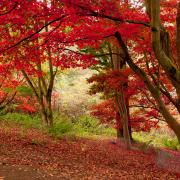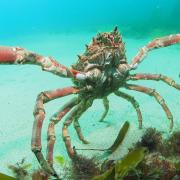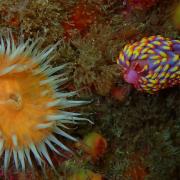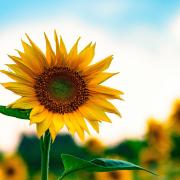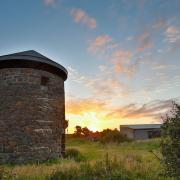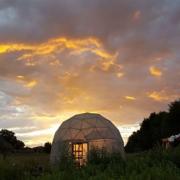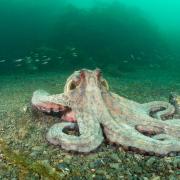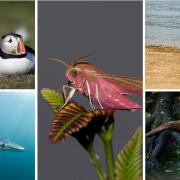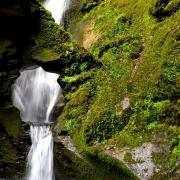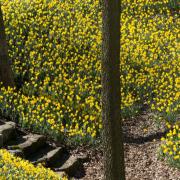Sarah Taylor, Penhale Sands Reserve Warden for Cornwall Wildlife Trust, reveals this north coast wildlife haven
Penhale – a Wildlife Paradise
Sarah Taylor, Penhale Sands Reserve Warden for Cornwall Wildlife Trust, reveals this north coast wildlife haven
Penhale Sands is the largest dune system in Cornwall, covering almost 2,500 acres and is home to the tallest dunes in Britain, reaching 90 metres in places. It lies on the north coast between Perranporth and Holywell. I have been in a ranger post here since 2003 and was born very close to the area and enjoy working at Penhale because of the variety of wildlife and habitats. Many people think it is just an area of grass, but in fact, hidden away, are many nationally and internationally rare species.
Early gentian, which is only found in two places in north Cornwall is a low-growing plant, forming tufts with dull purple flowers later in the summer and can be found commonly in many of the areas of short turf. Many of the plants here are very small due to the exposed conditions and lack of water and food in the sand, but also have special ways of helping them to survive. One example is Portland spurge, another rarity but common here that has fleshy seeds to stop it drying out. Unusually at Penhale, there are also many seasonally wet pools or dune slacks, which are where many rare flowers and other wildlife is found.
Shore dock, which is very rare internationally, has recently increased in numbers. We started experimentally ‘scraping’ some of these dune slacks, which resulted in the reappearance of large lakes in the winter, plus a brand new shore dock colony. Other precious plants include a type of fragrant orchid, with tall, vanilla-scented purple flowers and marsh helleborine, with delicate tall white flower spikes. Willows were cut back experimentally to try to increase their numbers and this has proved beneficial. Not all our rarities here are pretty - a rare liverwort, petalwort, is only found on eroded areas of Penhale Sands, so not all erosion is a bad thing.
Other more common plants, such as the wild carrot with its heads of tiny white flowers is the ancestor of our garden carrot. In fact many of the plants here, now seen as weeds, have historical medicinal and traditional uses. There are also thousands of insects found at Penhale, such as the silver studded blue butterfly. It is small and bright blue, with tiny silver dots under its wings. In a good year in June, literally clouds of these can be seen flying at one time.
“Many people think Penhale is just an area of grass, but in fact, hidden away, are many nationally and internationally rare species”
The Ministry of Defence (MOD) owns part of Penhale Sands for military training, but it is comparatively less disturbed than public access areas. For example, the lack of dogs means that ground-nesting skylarks are found in larger numbers here, although they are common over all Penhale. This is great news as their numbers have decreased nationally, due to loss of suitable habitat. Keep an ear open for their non-stop singing and see if you can spot them hovering high in the sky. They are small brown birds, but recognisable by a small tuft on their heads.
Other birds frequently seen soaring on the thermals are brown common buzzards, while around the cliffs you may be lucky enough to see peregrine falcons flying at incredible speeds after their prey of smaller birds. In the autumn look out for wheatears, with a distinctive white patch above their tail.
One of Cornwall Wildlife Trust’s main tasks on the site is controlling scrub from spreading onto species-rich areas, carried out either by cutting, or more recently by spraying with a scrub-specific chemical, which does not harm the dune vegetation but helps manage the scrub growth. Grazing is another tool, we have been using Shetland and Exmoor ponies but also plan to use Red Devon cattle. Rabbits remain the main grazers.
I run a variety of events for the public, educational activities for local schools and a range of walks, talks and briefings for the MOD. The MOD-owned land is not usually open to the public except on warden-led walks, but there is open access on the South West Coast Path and the Permissive Path along the dune tops. Bourne Leisure land and other publicly-owned land is open to all, so this in itself makes for some interesting differences – in some ways the public and non-public accessed areas form two very different dune systems.
To learn more about the wildlife found at Penhale Sands and how our work helps it survive, why not come on a warden-led walk. Otherwise, explore the public access areas and the coastal footpath/permissive path yourselves, which are a scenic and varied walk around the dunes and cliffs. I hope you enjoy the beautiful scenery and fascinating wildlife as much as I do! n
For details of events at Penhale Sands visit: cornwallwildlifetrust.org.uk /whatson
How to get to Penhale SandsGrid Ref: approximately SW760 550-SW768 587. There are a number of different parking areas around the dunes and parking is free on lay-bys along the back road between Perranporth and Cubert, on the inland edge of the dunes. Perran Sands Holiday Park charges daily for parking, ask at the reception for details. You can also pick up Penhale Sands leaflets at the Holiday Park. There is a National Trust car park at Holywell to access the Coast Pat
How to get to Penhale Sands
Grid Ref: approximately SW760 550-SW768 587.
There are a number of different parking areas around the dunes and parking is free on lay-bys along the back road between Perranporth and Cubert, on the inland edge of the dunes. Perran Sands Holiday Park charges daily for parking, ask at the reception for details. You can also pick up Penhale Sands leaflets at the Holiday Park. There is a National Trust car park at Holywell to access the Coast Path.







